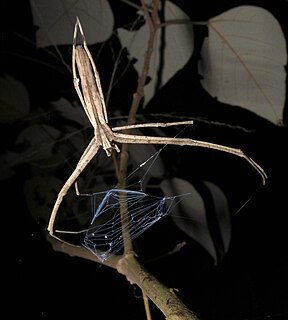
Deinopidae, also known as net casting spiders, is a family of cribellate spiders first described by Carl Ludwig Koch in 1850. It consists of stick-like elongated spiders that catch prey by stretching a web across their front legs before propelling themselves forward. These unusual webs will stretch two or three times their relaxed size, entangling any prey that touch them. The posterior median eyes have excellent night vision, allowing them to cast nets accurately in low-light conditions. These eyes are larger than the others, and sometimes makes these spiders appear to only have two eyes. Ogre-faced spiders (Deinopis) are the best known genus in this family. The name refers to the perceived physical similarity to the mythological creature of the same name. This genus also includes the humped-back spiders (Menneus).

The Pholcidae are a family of araneomorph spiders. The family contains over 1,800 pholcids, including those commonly known as the marbled cellar spider , daddy long-legs spider, granddaddy long-legs spider, carpenter spider, daddy long-legger, vibrating spider, gyrating spider, long daddy, and skull spider. The family, first described by Carl Ludwig Koch in 1850, is divided into 94 genera.

Orb-weaver spiders are members of the spider family Araneidae. They are the most common group of builders of spiral wheel-shaped webs often found in gardens, fields and forest. "Orb" can in English mean "circular", hence the English name of the group. Araneids have eight similar eyes, hairy or spiny legs, and no stridulating organs.

Crevice weaver spiders (Filistatidae) comprise cribellate spiders with features that have been regarded as "primitive" for araneomorph spiders. They are weavers of funnel or tube webs. The family contains 18 genera and more than 120 described species worldwide.

The southern house spider is a species of large spider in the family Filistatidae. Currently given the scientific name Kukulcania hibernalis, it was formerly known as Filistata hibernalis. Found in the Americas, it exhibits strong sexual dimorphism. It is occurs in the southern states of the USA, throughout Central America and some of the Caribbean, to southern Brazil, Uruguay and Argentina. The males may be mistaken for brown recluses because the two have similar coloration and body structure. However, compared to the brown recluse, male southern house spiders are typically larger in size, lack the distinctive violin shape on their cephalothorax, and have unusually long slender pedipalps. The females are dark brown or black and more compact. Both sexes may grow to be roughly 2 inches (5.1 cm) across, with the males typically having longer legs, and the females often having larger, bulbous bodies. The abdomen of the southern house spider is covered with fine velvety light gray hair.

The black house spider or common black spider is a common species of cribellate Australian spider, introduced to New Zealand and Japan. A closely related species, Badumna longinqua, the grey house spider, has a similar distribution, but has also been introduced to the Americas.

Portia labiata is a jumping spider found in Sri Lanka, India, southern China, Burma (Myanmar), Malaysia, Singapore, Java, Sumatra and the Philippines. In this medium-sized jumping spider, the front part is orange-brown and the back part is brownish. The conspicuous main eyes provide vision more acute than a cat's during the day and 10 times more acute than a dragonfly's, and this is essential in P. labiata′s navigation, hunting and mating.
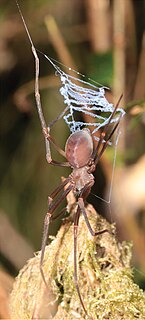
Cribellum literally means "little sieve", and in biology the term generally applies to anatomical structures in the form of tiny perforated plates.

Scytodes thoracica is a spitting spider, so called because it spits a venomous sticky silken substance over its prey. Its size ranges between 3–6 mm (0.12–0.24 in). The carapace is unusual in sloping upwards towards its rear end, whereas the abdomen slopes downwards.

Gradungulidae, also known as large-clawed spiders, is a spider family endemic to Australia and New Zealand. They are medium to large-sized haplogyne spiders with three claws and two pairs of book-lungs similar to Mygalomorphae. Some species build extensive webs with an upper retreat tangle and connecting threads to scaffolding. This supports the ladder-like catching platform that is glued to the ground. Progradungula, a large spider with long legs like Hickmania, and Macrogradungula are the only cribellate genera of the family.
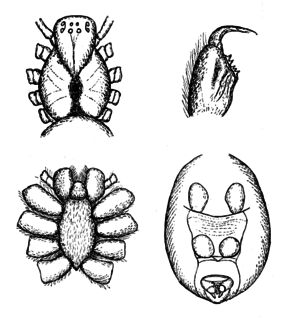
Hickmania is a monotypic genus of Australian cribellate araneomorph spiders in the family Austrochilidae, containing only the Tasmanian cave spider. The genus was first described by Willis J. Gertsch in 1958, and has been found only in Tasmania. It is the last of an old Gondwanan lineage, long since separated from its closest relatives in South America. It is an icon species for faunal conservation in Tasmania, and is named in honor of a professor at the University of Tasmania who specialized in spiders. The species name is derived from the Ancient Greek τρωγλοδύτης (troglodytes), meaning "cave-dweller".

The anatomy of spiders includes many characteristics shared with other arachnids. These characteristics include bodies divided into two tagmata, eight jointed legs, no wings or antennae, the presence of chelicerae and pedipalps, simple eyes, and an exoskeleton, which is periodically shed.
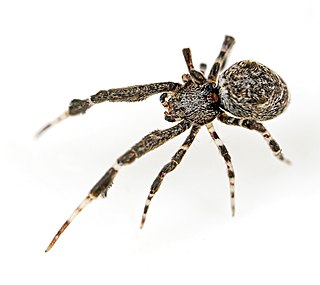
Uloborus plumipes is a species of Old World cribellate spider in the family Uloboridae. Common names include the feather-legged lace weaver and the garden centre spider, the latter name being due to its frequent occurrence of this spider in garden centres on the world. The species name is derived from the Latin pluma "feather" and pes "foot".

Pholcus phalangioides, commonly known as daddy long-legs spider or long-bodied cellar spider, is a spider of the family Pholcidae. It is also known as the skull spider due its cephalothorax resembling a human skull. This is the only spider species described by the Swiss entomologist Johann Kaspar Füssli, who first recorded it in 1775. Its common name of "daddy long-legs" should not be confused with a different arachnid species with the same common name, the harvestman (Opiliones).

Metepeira labyrinthea, the labyrinth orbweaver, is an American dollar coin-sized spider, with thin legs and a round, bulbous abdomen It is a member of the genus Metepeira in the family Araneidae. The female’s length is 5.3 mm, its carapace 2.3 mm, abdomen 3.3 mm, and extended legs 18.4 mm. The carapace is brown or gray, and the abdomen is dark with a white pattern. The legs alternate pale brown and dark brown, and the sternum is dark brown with a longitudinal yellow mark. The male spider is three-quarters of the female’s length, or slightly larger, with a darker carapace and with greater contrast between dark and light areas of the legs. Metepeira are easily distinguished from other Araneidae by their light eye region, white median line on the sternum, relative length of the leg segments, small male palpus, weakly sclerotized epigyne and the special composite web.

Portia schultzi is a jumping spider which ranges from South Africa in the south to Kenya in the north, and also is found in West Africa and Madagascar. In this species, which is slightly smaller than some other species of the genus Portia, the bodies of females are 5 to 7 mm long, while those of males are 4 to 6 mm long. The carapaces of both sexes are orange-brown with dark brown mottling, and covered with dark brown and whitish hairs lying over the surface. Males have white tufts on their thoraces and a broad white band above the bases of the legs, and these features are less conspicuous in females. Both sexes have tufts of orange to dark orange above the eyes, which are fringed with pale orange hairs. Males' abdomens are yellow-orange to orange-brown with blackish mottling, and on the upper sides are black and light orange hairs, and nine white tufts. Those of females are pale yellow and have black markings with scattered white and orange-brown hairs on the upper side. P. schultzi has relatively longer legs than other Portia, and a "lolloping" gait.
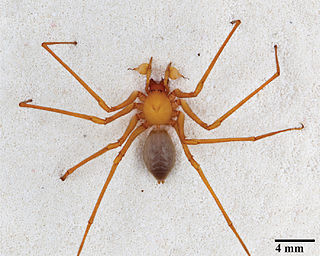
Trogloraptor is a genus of large spiders found in the caves of southwestern Oregon. It is the sole genus in the family Trogloraptoridae, and includes only one species, Trogloraptor marchingtoni. These spiders are predominantly yellow-brown in color with a maximum leg span of 3 in (7.6 cm). They are remarkable for having hook-like claws on the raptorial last segments of their legs.

Progradungula otwayensis, commonly known as the odd-clawed spider, is a species of cribellate spider endemic to the Great Otway National Park of Victoria, Australia. It is one of only two species in the gradungulid genus Progradungula.

Hypochilus thorelli is a species of spider in the family Hypochilidae. Unlike almost all other araneomorph or "true" spiders, members of the family have four book lungs. They are often called "lampshade spiders" because of the shape of their webs which are usually built underneath ledges or projections. H. thorelli is found in the southern Appalachian Mountains of the eastern United States.
Gelotia lanka is a species of spider of the genus Gelotia. It is endemic to Sri Lanka.


















